


 Copyright 2021 by Good Books Photos by Claire Barboza, Bonnie Matthews, and Meredith Special Interest Media. Photos on courtesy of Shutterstock. All rights reserved. No part of this book may be reproduced in any manner without the express written consent of the publisher, except in the case of brief excerpts in critical reviews or articles. All inquiries should be addressed to Good Books, 307 West 36th Street, 11th Floor, New York, NY 10018. Good Books books may be purchased in bulk at special discounts for sales promotion, corporate gifts, fund-raising, or educational purposes.
Copyright 2021 by Good Books Photos by Claire Barboza, Bonnie Matthews, and Meredith Special Interest Media. Photos on courtesy of Shutterstock. All rights reserved. No part of this book may be reproduced in any manner without the express written consent of the publisher, except in the case of brief excerpts in critical reviews or articles. All inquiries should be addressed to Good Books, 307 West 36th Street, 11th Floor, New York, NY 10018. Good Books books may be purchased in bulk at special discounts for sales promotion, corporate gifts, fund-raising, or educational purposes.
Special editions can also be created to specifications. For details, contact the Special Sales Department, Good Books, 307 West 36th Street, 11th Floor, New York, NY 10018 or . Good Books is an imprint of Skyhorse Publishing, Inc., a Delaware corporation. Visit our website at www.goodbooks.com. 10 9 8 7 6 5 4 3 2 1 Library of Congress Cataloging-in-Publication Data is available on file. Cover design by Laura Klynstra Cover photo courtesy of Meredith Special Interest Media Print ISBN: 978-1-68099-757-6 Ebook ISBN: 978-1-68099-771-2 Printed in China Contents  Getting Started Pasta is one of the most versatile and universally appreciated foods.
Getting Started Pasta is one of the most versatile and universally appreciated foods.
Its beloved by kids in the form of macaroni and cheese, spaghetti with marinara, or straight up with a pat of butter. Its perfect for date night at home (try Shrimp with Sun-Dried Tomatoes on ) is ideal for a summer picnic. Pasta can be dressed up with freshly grated Parmesan and cracked pepper or dressed down with some Velveeta tossed in a slow cooker. This cookbook offers a wide range of easy-to-prepare pasta dishes so youre sure to find something for any occasionincluding a last-minute Tuesday-night dinner with the kids. These recipes were collected from and tested by home cooks across the country, and their flavor profiles are just as diverse as the people who created them. The one thing all the recipes have in common is that theyre easy.
Each recipe tells you the prep time required as well as the time needed for cooking or baking. Most recipes require 15 minutes or less of prep, and very few need more than 30 minutes. The cooking time varies according to the recipe and the appliance used. Ingredients used in this book shouldnt be hard to find in your local grocery store, and most are inexpensive, too. Although some recipes are simpler than others, none should stress you out. Just read the recipe all the way through before beginning to make sure you have all the ingredients (or have a plan to substitute for any youre missing) and to get a sense of where the recipe is going before you start.
Its also helpful to do any prep work ahead of timefor example, veggies can be chopped and stored in the refrigerator in advance. Youll see little icons on the top of each recipe that indicate whether the recipe is made using your stove, oven, slow cooker, or Instant Pot. Youll also see some recipes that are chilled, and some that require two appliancesperhaps the pasta is cooked on the stovetop and then thrown in the slow cooker with the other ingredients. If youre looking for a recipe made with a specific appliance, check the index. For example, under Instant Pot, youll find Insta Pasta la Maria (), and more. Of course, slow-cooker recipes can also be made in an Instant Pot using the Slow Cook setting.
Beyond the appliances, you wont need many cooking tools. A big pot is good for cooking the pasta, and have a strainer handy for when the pasta is done. Youll want a wooden spoon for stirring the pasta and sauces and a saut pan or skillet. A cheese grater is nice for finishing touches. Tongs or a pasta fork are helpful for serving. Thats about it! Freezing Sauces and Baked Pasta Dishes The sauce recipes in this book () can be made and frozen for future use.
When youre done making the sauce, cool it completely, then ladle into plastic containers with secure, airtight lids or into airtight plastic freezer bags. Label with the name of the sauce and the date and use within three months. To use, transfer to the refrigerator to thaw completely, then heat in a skillet over low heat. For cream-based sauces, be sure to stir frequently as youre heatingits likely that the sauce will have separated to some degree, so the stirring helps return the sauce to its original consistency. Baked pasta dishes can also be frozen. Bake the dish in a disposable tin or use a pan youre not likely to need again anytime soon.
Allow the pasta to cool completely. Cover tightly with a double layer of foil before freezing. Label with recipe name and date and use within three months. To reheat, you can transfer the pan directly from the freezer to the oven and bake at 350F until heated through. Choosing Pasta Pasta Shapes For most of the recipes in this book, a specific shape of pasta is recommendedlinguine or penne or farfalle, for example. But with the exception of recipes like stuffed shells or ravioli that clearly require actual pasta shells or ravioli, feel free to substitute whatever shape of pasta youre in the mood for.
There are over 500 pasta shapes to choose from, though you may only have a dozen or so represented in your local grocery store. Still, thats a lot of options to play around with. Just keep in mind that pasta shaped like scoops or with hollow centers or deep divots (think shells, penne, rotini) are better at holding thick or chunky sauces, while flat noodles (fettuccine, linguine, spaghetti) are better suited to thinner sauces.  Pasta Varieties Most grocery stores carry pastas made from a variety of starches. You can likely find a wide variety of shapes made from semolina, which is derived from durum wheat. This is the most traditional kind of pasta, the delicious, satisfying, comforting pasta youre probably used to.
Pasta Varieties Most grocery stores carry pastas made from a variety of starches. You can likely find a wide variety of shapes made from semolina, which is derived from durum wheat. This is the most traditional kind of pasta, the delicious, satisfying, comforting pasta youre probably used to.
But you may also find whole wheat pasta, a somewhat healthier alternative, as well as various gluten-free pastas, which may be made from rice flour, quinoa, amaranth, corn flour, or some combination of those. Gluten-free pastas have come a long way in the last decade and the flavor and texture of many options are truly satisfying, if not an exact replica of traditional pasta. More recently, a myriad of alternative pastas have shown up on shelves, toopastas made from lentils, black beans, yellow peas, chickpeas, cassava, sweet potatoes, cauliflower, and more. Try them! Just remember that cooking time varies significantly between these kinds of pastas, so follow the instructions on the package they come in. Cooking Pasta Theres no need to make cooking pasta complicated, but there are a few things you can do to make the process efficient and to ensure a delicious result. First, use a pot thats large enoughand fill it full enough with waterfor the pasta to move freely in the water.
You dont want the noodles to be cramped. Use about 4 quarts of water per pound of pasta. Second, allow the water to come to a full rolling boil (keep a lid on to speed this up), and then add about 1 tablespoon of salt per 4 quarts of pasta/one pound of pasta. Salted water takes longer to boil, so dont add the salt until the water is already boiling. Some people like to put a glug of olive oil in the water to help prevent the pasta from sticking together. However, this also makes the pasta slippery, which means sauce wont cling to it as well.
Next page


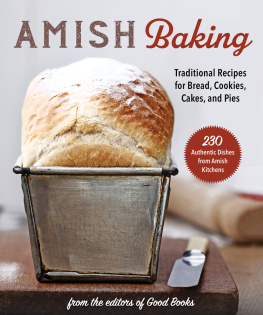

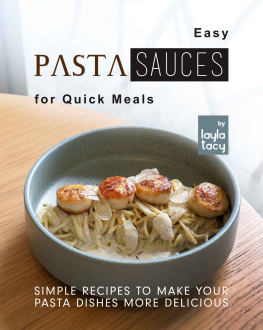
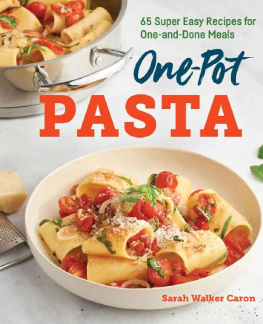
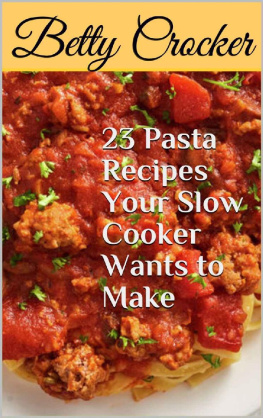
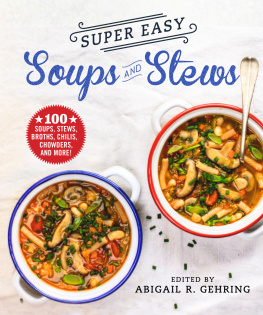
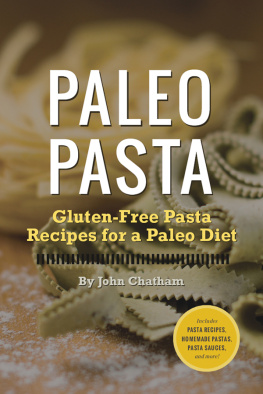
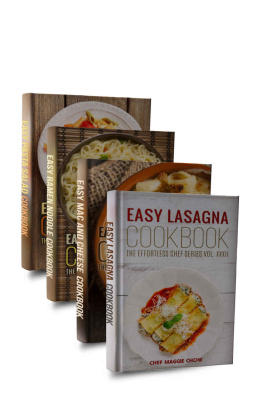



 Copyright 2021 by Good Books Photos by Claire Barboza, Bonnie Matthews, and Meredith Special Interest Media. Photos on courtesy of Shutterstock. All rights reserved. No part of this book may be reproduced in any manner without the express written consent of the publisher, except in the case of brief excerpts in critical reviews or articles. All inquiries should be addressed to Good Books, 307 West 36th Street, 11th Floor, New York, NY 10018. Good Books books may be purchased in bulk at special discounts for sales promotion, corporate gifts, fund-raising, or educational purposes.
Copyright 2021 by Good Books Photos by Claire Barboza, Bonnie Matthews, and Meredith Special Interest Media. Photos on courtesy of Shutterstock. All rights reserved. No part of this book may be reproduced in any manner without the express written consent of the publisher, except in the case of brief excerpts in critical reviews or articles. All inquiries should be addressed to Good Books, 307 West 36th Street, 11th Floor, New York, NY 10018. Good Books books may be purchased in bulk at special discounts for sales promotion, corporate gifts, fund-raising, or educational purposes. Getting Started Pasta is one of the most versatile and universally appreciated foods.
Getting Started Pasta is one of the most versatile and universally appreciated foods. Pasta Varieties Most grocery stores carry pastas made from a variety of starches. You can likely find a wide variety of shapes made from semolina, which is derived from durum wheat. This is the most traditional kind of pasta, the delicious, satisfying, comforting pasta youre probably used to.
Pasta Varieties Most grocery stores carry pastas made from a variety of starches. You can likely find a wide variety of shapes made from semolina, which is derived from durum wheat. This is the most traditional kind of pasta, the delicious, satisfying, comforting pasta youre probably used to.